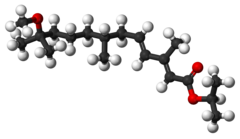
| |
| Names | |
|---|---|
| Preferred IUPAC name
Propan-2-yl (2E,4E)-11-methoxy-3,7,11-trimethyldodeca-2,4-dienoate | |
| Other names
Methoprene, Altosid, Apex, Diacan, Dianex, Kabat, Minex, Pharorid, Precor, ZR-515
| |
| Identifiers | |
3D model (JSmol)
|
|
| ChEBI | |
| ChEMBL | |
| ChemSpider | |
| ECHA InfoCard | 100.049.977 |
| KEGG | |
| MeSH | C093000 |
PubChem CID
|
|
| UNII | |
CompTox Dashboard (EPA)
|
|
| |
| |
| Properties | |
| C19H34O3 | |
| Molar mass | 310.48 g/mol |
| Appearance | Liquid |
| Boiling point | 100 °C (212 °F; 373 K) at 0.05 mmHg |
| Pharmacology | |
| QP53AX28 (WHO) | |
| Hazards | |
| Occupational safety and health (OHS/OSH): | |
Main hazards
|
Eye irritant |
Except where otherwise noted, data are given for materials in their standard state (at 25 °C [77 °F], 100 kPa).
| |
Methoprene is a juvenile hormone (JH) analog which acts as a growth regulator when used as an insecticide. It is an amber-colored liquid with a faint fruity odor.
Methoprene does not kill insects. Instead, it interferes with an insect’s life cycle and prevents it from reaching maturity or reproducing.[2] Juvenile growth hormones must be absent for a pupa to molt to an adult, so methoprene-treated larvae will be unable to successfully change from pupae to adults. This breaks the biological life cycle of the insect, preventing recurring infestation.
Methoprene is considered a biological pesticide because rather than controlling target pests through direct toxicity, methoprene interferes with an insect’s lifecycle and prevents it from reaching maturity or reproducing.[3]
- ^ Merck Index, 11th Edition, 5906.
- ^ "Update of the March 1991 Methoprene R.E.D. Fact Sheet" (PDF). epa.gov. United States Environmental Protection Agency. June 2001. Archived (PDF) from the original on 2022-10-20. Retrieved 2022-12-01.
- ^ "Insect Growth Regulators: S-Hydroprene (128966), S-Kinoprene (107502), Methoprene (10401), S-Methoprene (105402) Fact Sheet" (PDF). U.S. Environmental Protection Agency Office of Pesticide Programs. 2015-08-20.